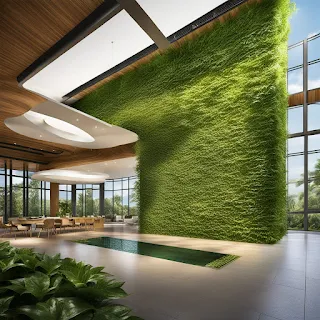Embracing Green Building and Sustainable Construction Principles
Introduction
In an era where ecological sustainability is paramount, green building and sustainable construction practices have evolved into guiding principles, transcending mere catchphrases. These principles significantly influence the design, construction, and utilization of our buildings and infrastructure, underlining the urgency of harmonizing our living spaces with the environment. This comprehensive article, authored by Akhand Dutta, explores the fundamental tenets that define green building and sustainable construction. Our journey takes us through the importance of these principles and their real-world implications.
Defining Green Building
Green building is a comprehensive approach to construction that emphasizes minimizing a building's environmental footprint while ensuring the well-being of its occupants. It's a holistic concept, shaping every facet of a building's lifecycle, from initial planning and design to construction, operation, maintenance, and ultimately, deconstruction.
Fundamental Principles of Green Building and Sustainable Construction
1. Energy Efficiency
Energy efficiency is a cornerstone of green building. Buildings account for a substantial portion of global energy consumption and carbon emissions. Sustainable construction concentrates on minimizing energy use by integrating energy-efficient design, advanced insulation, and efficient lighting and HVAC systems.
2. Sustainable Materials
Green buildings prioritize the use of eco-friendly materials, advocating responsible sourcing, the utilization of renewable and recycled resources, and waste reduction during construction. Sustainable materials are chosen for their capacity to enhance indoor air quality and decrease a building's carbon footprint.
3. Water Efficiency
Responsible water use is a central tenet of sustainable construction. Low-flow fixtures, rainwater harvesting, and wastewater recycling are all strategies that lessen water consumption and contribute to reduced energy demands for water treatment and distribution.
4. Indoor Air Quality
Ensuring excellent indoor air quality is an imperative of green building. This involves selecting low-emission materials, implementing effective ventilation systems, and employing robust filtration processes. Enhanced indoor air quality translates to improved occupant health and productivity.
5. Waste Reduction
Green construction places emphasis on waste minimization and diverting waste from landfills. This is achieved by employing efficient construction practices, recycling materials, and repurposing resources, thereby conserving valuable resources and reducing disposal costs.
6. Site Selection and Design
A building's location significantly influences its environmental impact. Sustainable construction takes into account site selection, land use, and community connectivity to minimize the environmental disruption caused by construction. It also promotes walkability and the use of public transportation.
7. Renewable Energy Integration
Green buildings frequently integrate renewable energy sources such as solar panels, wind turbines, or geothermal systems. These sources reduce the building's dependence on fossil fuels, contributing to a more sustainable energy landscape.
8. Adaptive Reuse and Historic Preservation
Sustainable construction principles extend beyond new construction to encompass the adaptive reuse and preservation of historic structures. Retrofitting existing buildings with green technologies and materials can be more environmentally friendly than demolition and new construction.
9. Biodiversity and Landscaping
Landscaping around a building can have a significant impact on the local ecosystem. Sustainable construction promotes biodiversity through the use of native plants and landscaping techniques that enhance the surrounding environment.
10. Life-Cycle Assessment
Life-cycle assessment (LCA) is a critical aspect of green building. It involves evaluating a building's environmental impact throughout its entire life cycle, from construction and operation to eventual demolition. LCA assists in making informed decisions about materials and design elements.
Examples of Green Building in Action
To better understand the practical application of these principles, let's explore real-world examples:
1. Passive House Design
Passive house design represents a remarkable example of energy-efficient green building. These homes are designed to be airtight and highly insulated, minimizing the need for traditional heating and cooling systems. They harness natural heat sources, such as sunlight, and use heat recovery ventilation to maintain indoor air quality.
2. LEED-Certified Buildings
Leadership in Energy and Environmental Design (LEED) certification is globally recognized as a benchmark for green building. LEED-certified buildings adhere to a range of green building principles, from energy efficiency and sustainable materials to indoor air quality and waste reduction.
3. Zero-Energy Homes
Zero-energy homes are designed to produce as much energy as they consume. Achieving this involves energy-efficient design, on-site renewable energy generation, and effective insulation.
4. Green Roofs
Green roofs, covered with vegetation, reduce stormwater runoff, insulate buildings, and provide habitat for wildlife.
5. LEED for Existing Buildings (LEED EB: O+M)
LEED for Existing Buildings assesses factors like energy efficiency, water conservation, waste management, and indoor air quality in buildings already in operation. It encourages ongoing sustainability practices to improve the environmental performance of these structures.
Benefits and Considerations
The adoption of green building and sustainable construction principles yields numerous benefits, including lower operating costs, enhanced health and comfort, reduced environmental impact, increased property value, positive public image, and greater resilience. However, challenges such as initial costs, complexity, regulatory hurdles, stakeholder education, and continuous monitoring should also be considered.
A Call to Embrace Sustainable Construction
In conclusion, the principles of green building and sustainable construction represent a profound shift in our approach to the built environment. These principles prioritize ecological responsibility, occupant well-being, and the long-term conservation of resources. By adhering to these principles, we can mitigate our environmental impact, enhance the quality of our constructed surroundings, and create spaces that are functional, sustainable, and harmonious with the natural world.
As a passionate advocate for sustainable construction and a firm believer in the principles of green building, I invite you to delve further into this transformative field. Consider how these principles can be applied in your own construction projects and be a part of the positive change that our world urgently needs, one building at a time.
For more insights on sustainable construction and green building practices, visit the CEWA Civil Engineering website and discover how our commitment to sustainability shapes our projects and our vision for a greener, more sustainable future.
.jpg)
.jpg)
.jpg)
